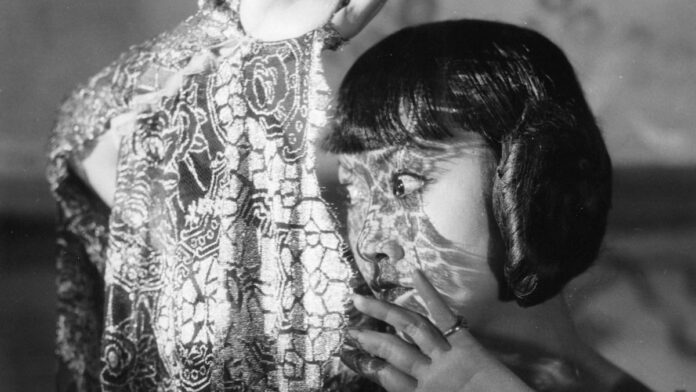Let Me Dream Again: Essays on the Moving Image, by Luke McKernan
Sticking Place Books, September 2025,
In case there could be anyone reading this site who doesn’t know, Luke McKernan is a media historian, formerly Lead Curator, News and Moving Image at the British Library. Also a formidably erudite and trailblazing blogger on moving image culture, especially silent cinema, but not exclusively. This collection of essays from across his many sites, gives a rich flavour of his expertise in analysis, archival curation and nostalgia.
In this book, Luke McKernan comments on the moving image in all its multiple forms. Let Me Dream Again – beautiful title – is crammed with insights into history, technology, and humanity. Because these essays, on a staggering variety of topics, began their lives as blogposts, they have the freshness of a live response to a moment in time – whether McKernan is reading 21st-century online comments on a silent film from 1903, or channel-hopping during the 2016 Olympics. He proves an excellent guide to the many ways that the storytelling impulse survives, and adapts to each new medium, from magic lantern slides to Artificial Intelligence.
The Silent Film Universe, by Ben Model
Undercrank Productions, June 2025, £27
Ben Model is many things: silent film accompanist, Blu-ray publisher, co-host of the Silent Comedy Watch Party, educator, podcaster, and all round cinematic evangelist. He is also an author and this book is his latest publication, a personal, and comprehensive introduction to the whys and wherefores of silent cinema. I would buy this book for the silent-curious friend in your life who doesn’t know where to begin and is bursting with questions.
In just under 200 pages, Model covers topics including speed (see the name of his company, he knows all about this) aesthetics, accompaniment, performance, intertitles and more. Even modern silents. The book is punchy, clear and friendly, yet very informative. He uses examples from well-known and easy to find films, but he also provides video clips online here. Nifty. Model’s bias, like his expertise, leans towards American comedy, but ranges wider. I think we can all get on board with these words from Model: “Silent film is not a dead language. Silent film can still work today.” All this, and a foreword by Jeanine Basinger.
The Reel Thrilling Events of Bank Robber Henry Starr: From Gentleman Bandit to Movie Star and Back Again, by Mark Archuleta
University of North Texas Press, July 2025, £26.99
Who? No, me neither until this book landed on my desk. But buckle up, because this story is quite a ride. Henry Starr, in a beautiful example of nominative self-determinism, briefly became a film star. Well star may be stretching it but he played the lead in a film. And he did so, after, before and because of being a bank robber. As Archuleta writes, “Henry Starr was a horseback gunslinger who robbed more banks than any man in American, but in 1919 motion pictures were the new Wild West.” The film Starr appeared in, A Debtor to the Law (1919), is now presumed lost, but Archuleta compiles plenty of evidence, from his criminal career and the publicity surrounding the movie, to tell the story of a man who several lives, all of them the stuff of legend. Which of course, is the only thing fit to print in the Wild West.
Not Your China Doll: The Wild and Shimmering Life of Anna May Wong, by Katie Gee Salisbury
Faber & Faber, Paperback August 2025, £12.99
Katie Gee Salisbury is an American writer and photographer from Southern California, of Chinese heritage. She was struck by images of Anna May Wong in a photo archive, and began to research the fascinating life of this iconic film star, released this summer in paperback. The result is this refreshingly novelistic, open-minded biography of an actress with a complicated career and an enduring appeal. None the less rigorously researched for being told with the pace and style of a fiction book, Not Your China Doll sometimes encourages the reader to sense-check the received narrative about Wong. “Anna May faced more challenges than most. Racism undoubtedly hindered her career, leading many to conclude that she was a woman before her time. But what if they’re wrong? What if we have it backward? What if Anna May Wong was right where she was supposed to be all along?”
The emphasis is therefore on Wong’s success and her legacy, her magnetic presence on film, her activism and her network of Asian-American peers in the movie industry rather than the low-budgets, the yellowface co-stars and the jobs that got away. It works, but mostly because this is an engrossing life of a brilliant woman, generously told, a story of the entertainment industry at its most glamorous and at its ugliest. And that we always want to hear more about the exceptional Anna May Wong.
To Be An Actress: Labor and Performance in Anna May Wong’s Cross-Media World, by Yiman Wang
Feminist Media Histories, University of California Press, 2024, £30 (paperback)/10.99 (ebook), or open access via luminosoa.org
Speaking of which, I must mention this book by Yiman Wang, which is an academic study of Anna May Wong’s career. So a very different kind of book, but telling the same story and with almost as much colour as Salisbury’s biography. Wang, who is professor of Film & Digital Media at the University of California, Santa Cruz, focuses on Wong’s performance labour as an actress and in the crafting of her media image. She uses a broad variety of resources, from the movies, to Wong’s archives, to media representations, to trace exactly how Anna May Wong created her career in film, TV and theatre, work that was always gendered and racialised. Wang begins with the sharpness of Wong’s wit in the face of racist media coverage and her mission is to switch the focus from the glamour of a nostalgically remembered star to the active legacy of a media worker.
Film Critics and British Film Culture: New Shots in the Dark, Ed. Robert Shail and Sheldon Hall
Edinburgh University Press, August 2025, £95
Disclaimer: I have a chapter in this on you-know-who, C.A. Lejeune. But I devoured the rest. Ever quoted or questioned a critic? Ever wondered if a critic can influence the box office or create a deeper change in the public’s perception of cinema? Every seriously considered what a movie critic does all day? Well, then this collection of essays on British film criticism by a collection of scholars and critics, is definitely for you. Bonus points if British cinema and cinemagoing are your bag.
Like a couple of the other books here mentioned, this is not entirely confined to the silent era, but for example, James Chapman’s analysis of how British critics centred the directorial influence (hurrah for Lejeune once again, and Iris Barry too) is very much our territory. Ditto, Lies Lanckman’s fascinating take on Picturegoer as a democratic pre-internet forum for amateur film crit and fandom.
But for the omnivorous film fan, of a historical bent, there is much more here to enjoy. Melanie Selfe on critics as celebrities and cultural role models, Laura Mayne on Dilys Powell, Henry K. Miller on Raymond Durgnat, Andrew Moor on the film criticism in Gay News, Ieuan Franklin on Time Out and Sheldon Hall on Radio Times, including testimony by Veronica Hitchcock and Geoff Brown on working there. Plus Robert Shail’s investigaton of Leslie Halliwell’s attack on Monthly Film Bulletin in the 1970s, and writer David McGillivray’s deeply entertaining memories of film criticking and mischief-making full-time.
Oh, and what can I say about the price? It’s academic publishing. Request this for your library or consider it an investment piece, like a designer handbag, but far, far cheaper. And considerably more chic.
- Silent London will always be free to all readers. If you enjoy checking in with the site, including reports from silent film festivals, features and reviews, please consider shouting me a coffee on my Ko-Fi page.









